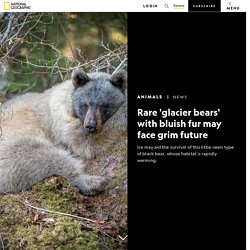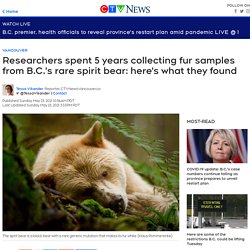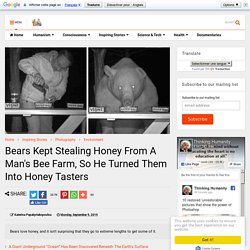

British Columbia ends grizzly bear hunt, calls it ‘no longer socially acceptable’ "It's no longer socially acceptable to the vast majority of British Columbians to hunt grizzly bears," said Doug Donaldson, the Minister of Forests, Lands and Natural Resources.

The government estimates there are about 15,000 grizzlies in the province. The province's environment and forests ministers announced the ban on Monday, saying they were acting on the basis of a program of consultation with stakeholder groups, the public and First Nations, most of whom recommended a ban to protect the bears. The move follows, and effectively expands, an August commitment to end the trophy hunting of grizzly bears and stop all hunting of grizzly bears in the Great Bear Rainforest. Mr. Donaldson told a news conference he did not expect that the continuing First Nations hunt would kill many bears, suggesting there are less than 100 hunters who use bears for food. Mr. Joe Foy of the Wilderness Committee environmental group called the measure "tremendous news" that sets a global example.
Rare 'glacier bears' with bluish fur may face grim future. Tania Lewis is one of the world’s experts on glacier bears, but even she has only seen these mysterious animals a handful of times.

As a wildlife biologist at Glacier Bay National Park and Preserve in Alaska, Lewis studies the park’s small, little-seen population of what are genetically black bears, but whose coats range from mostly black with a silvery fringe to entirely bluish gray. “To have a rare color … that’s not found anywhere on Earth—there’s a story there,” Lewis says. In their latest research, Lewis and colleagues have offered new clues into why glacier bears are so unusual. The research also has revealed potential challenges to the bears’ future as temperatures rise due to global climate change. The team identified 10 black bear populations in and around the national park, four of which contained glacier bears. (7) Facebook. Are Bears Dangerous?
When bears lose their fear of people, are they more likely to attack?

Answer is NO ! B.C.'s rare spirit bear: researchers investigate 'chemical signatures' on fur. VANCOUVER -- A group of researchers, who spent five years collecting and analyzing the fur of B.C.’s rare white spirit bears, have released some of their findings.

Spirit bears, found in central and northern coastal areas, are culturally significant to the Kitasoo Xaixais and Gitga’at First Nations, and the chance to see them in the wild attracts eco-tourists from around the world. The researchers wanted to know more about the diet and habitat needs of the bears, who carry a rare genetic mutation. “There's a lot of interest for local First Nations’ governments to steward these bears, to make sure we're providing them adequate habitat and making land and marine decisions that benefit the bears,” said Christina Service, a researcher for the Kitasoo Xaixais First Nation. Actual size of bears. In case you were... - Raphael Terranus.
(3) Facebook. (3) Facebook. Björn med vit päls fångades på bild. Ever Wonder What The World's Rarest Bear Looks Like? Better Hurry. Bears: Facts & Pictures. Google Earth Live: Explore.org invites you to hang out with Alaskan Brown Bears. Bears Kept Stealing Honey From A Man's Bee Farm, So He Turned Them Into Honey Tasters. Bears love honey, and it isn't surprising that they go to extreme lengths to get some of it.

They love it so much that they cannot resist raiding beehives and cause a real headache for many beekeepers. Those adorable apex predators are very common guests at several bee farms, but they're very unwelcome since sometimes the damages they cause are worth thousands. Nevertheless, many beekeepers, such as Ibrahim Sedef, try their best to keep them away from beehives. As DHA reports, Ibrahim Sedef lives in Trabzon, Turkey. He's an agricultural engineer that works in beekeeping. To protect the hives, Sedef tried to secure them by putting metal cages around them. Therefore, the beekeeper decided to learn more about the bears’ movement and behavior. While trying to figure out a way to outsmart the greedy animals, Sedef came up with a genius idea: he decided to turn these bears into honey tasters because they have a good taste for honey.
More info: dha.com.tr. Cubs in tree,smfile,18×24,20160703-D804405. A Photographer Spent 117 Hours In The Severe Cold To Get These Incredible Shots. Every year, from mid-February to mid-March, a grand event happens in the Wapusk National Park in Canada: polar bears come out from their caves with their four-month-old babies for the first time.

Last year, Daisy Gilardini, a professional wildlife photographer, decided to go photo hunting for pictures of the Cubs’ first steps. Daisy spent 13 days in the park and waited for 117 hours in front of the cave while it was about −122°F (-50 °C) outside. It makes me shiver just thinking about it! Jennifer Mulloy. Carol Fox - Since the other three pictures have had such a... Bears: Facts & Pictures.